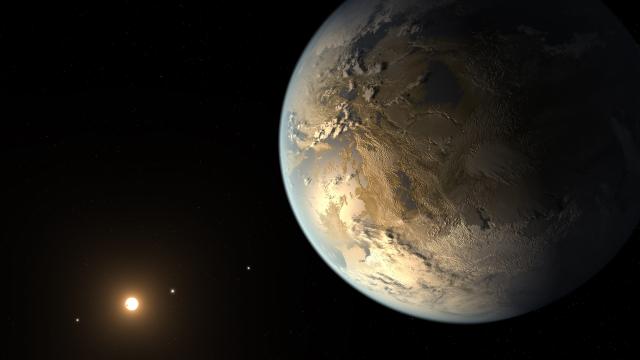Since the 1960s, the Drake Equation has been used to predict how many communicative extraterrestrial civilisations exist in the Milky Way galaxy. Along these same lines, a new formula seeks to estimate the frequency at which life emerges on a planet — a calculation that might allow us to figure out the likelihood of life arising elsewhere in the universe.
An artist’s conception of Kepler-186f, an Earth-like planet that could contain the chemical ingredients for life (Image: NASA Ames/SETI Institute/JPL-Caltech)
The new equation, developed by Caleb Scharf from Columbia Astrobiology Center and Leroy Cronin from the School of Chemistry at the University of Glasgow, can’t yet be used to determine the chances of life existing elsewhere, but it’s a promising start in that direction.
Fundamentally, the researchers hope that their new formula, described in the latest edition of the Proceedings of the National Academy of Sciences, will encourage scientists to study the various factors that link origin-of-life events to specific characteristics within planetary environments. More conceptually, they hope their equation will eventually be used to predict the frequency at which planets experience an origin-of-life event, also known as abiogenesis. As the researchers explained to Gizmodo, “This would allow us to figure out the likelihood of life arising elsewhere in the Universe.”
Above: Video explainer on the Drake Equation
Those familiar with the Drake Equation will be familiar with how this works. Back in 1961, astronomer Frank Drake crafted a probabilistic formula to help estimate the number of active, radio-transmitting alien civilisations in the galaxy. His formula was packed with several unknown values, including the average rate of star formation, the average number of planets that can potentially support life, the fraction of planets that actually go on to develop intelligent life and so on. We don’t have a definitive answer to the Drake Equation, but we’re certainly getting better at filling in the blanks.
The new formula developed by Scharf and Cronin isn’t an attempt to replace the Drake Equation. Instead, it’s meant as a deep dive into the more granular issue of abiogenesis.
Here’s what the formula looks like:

Where :
- Nabiogenesis (t) = Likelihood of origin of life events
- Nb = Number of potential building blocks
- No = Mean number of building blocks per organism, or biochemically significant system
- fc = Fractional availability of building blocks during Time t
- Pa = Probability of assembly per unit time
It looks complicated, but it’s fairly straight forward. The equation is basically saying that the probability of life arising on a planet is closely tied to the amount of life-sustaining chemical “building blocks” available on the planet.
By building blocks, the researchers are referring to the minimum chemicals required to start the processing of making a simple life form. This could be DNA/RNA base pairs or amino acids, but it could also mean any available molecules or materials on the planet that can get involved with the chemical reactions that could lead to life. Chemistry is still chemistry across the universe, but other planets may have stumbled upon different approaches for spawning life.
More specifically, Scharf and Cronin’s equation states that the odds of life emerging on a planet are driven by the number of building blocks that could possibly exist, the number of building blocks available, the probability that these building blocks will actually go on to create life (that is, assembly) and the number of building blocks needed to produce a given life form. So, in addition to identifying the chemical prerequisites for life, this equation seeks to determine the frequency at which reproductive molecules emerge. Here on Earth, abiogenesis was characterised at the moment when RNA emerged. This critical step was followed by the rise of simple single-celled life (prokaryotes), and then complex single-celled life (eukaryotes).
“Our approach links the chemistry on the planet to the global rate of life starting — this is important as now are starting to find lots of solar systems with multiple planets,” Caleb told Gizmodo. “For example, we think that having a smaller planet nearby — like Mars — is potentially important since it got cooler quicker than the Earth… some chemistry could ‘get started’ and then impact ejections could transport that complex chemistry to earth to help ‘kick-start’ the chemistry on Earth.”
Indeed, one of the major realisations of this study is that planets cannot be studied in isolation. As Caleb noted, Mars and Earth may have been involved in cross-contamination at some point in our distant past — an exchange of materials that may have contributed to the rise of life on Earth. This new research suggests that the transfer of chemical building blocks between nearby planets could significantly increase the odds of life arising on them.
So are we any closer to knowing how much life exists in the universe?
“This is a tough question to answer,” said Caleb. “What our work suggests is that solar systems with more than one planet could be excellent candidates for closer study — indeed the main take home message is to concentrate on multi-planet systems and see if any of the planets look ‘alive’.” By alive, Caleb says we should look for signs of changing atmospheres, complex chemistry, evidence of complexity and evidence of variations in climate that could be driven by biological organisms.
We don’t have enough empirical evidence to complete Scharf and Cronin’s equation at the moment, but that could change in the future. Over the coming decades we’ll be able to use the James Webb Telescope and MIT’s Tess Mission (Translating ExtraSolar planet Survey mission) to come up with the missing values. Eventually, and hopefully quite soon, we’ll finally know the answer to this lingering question.
